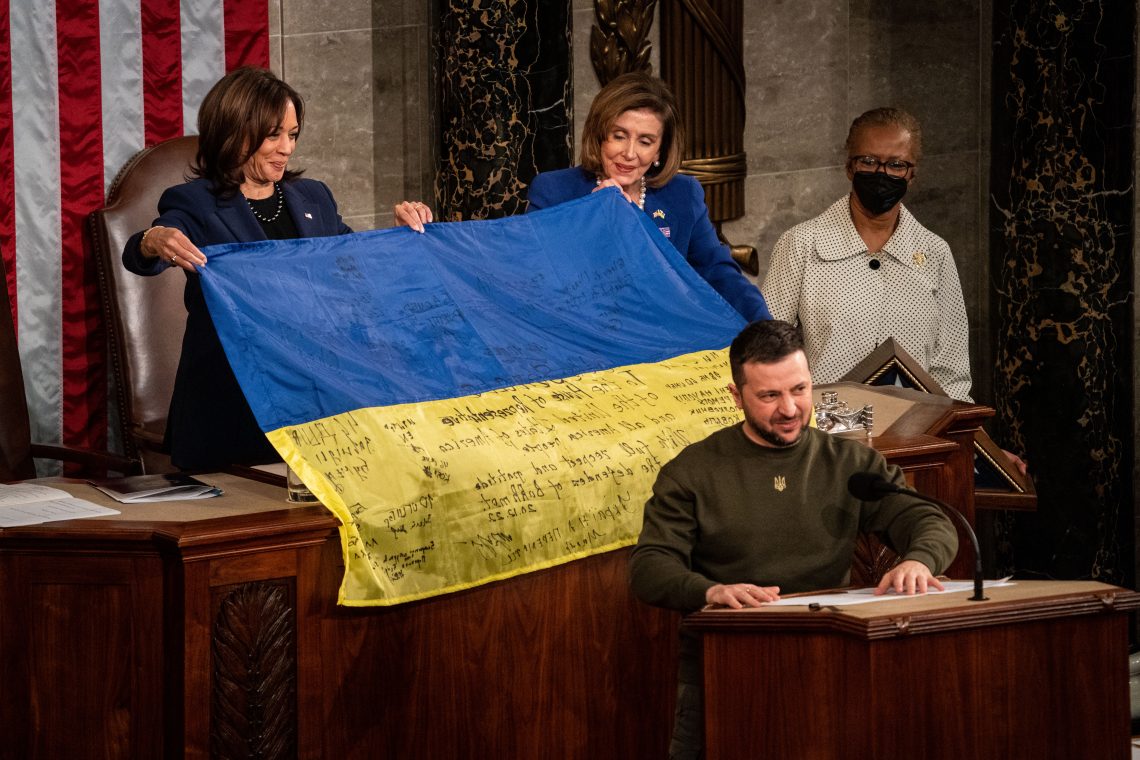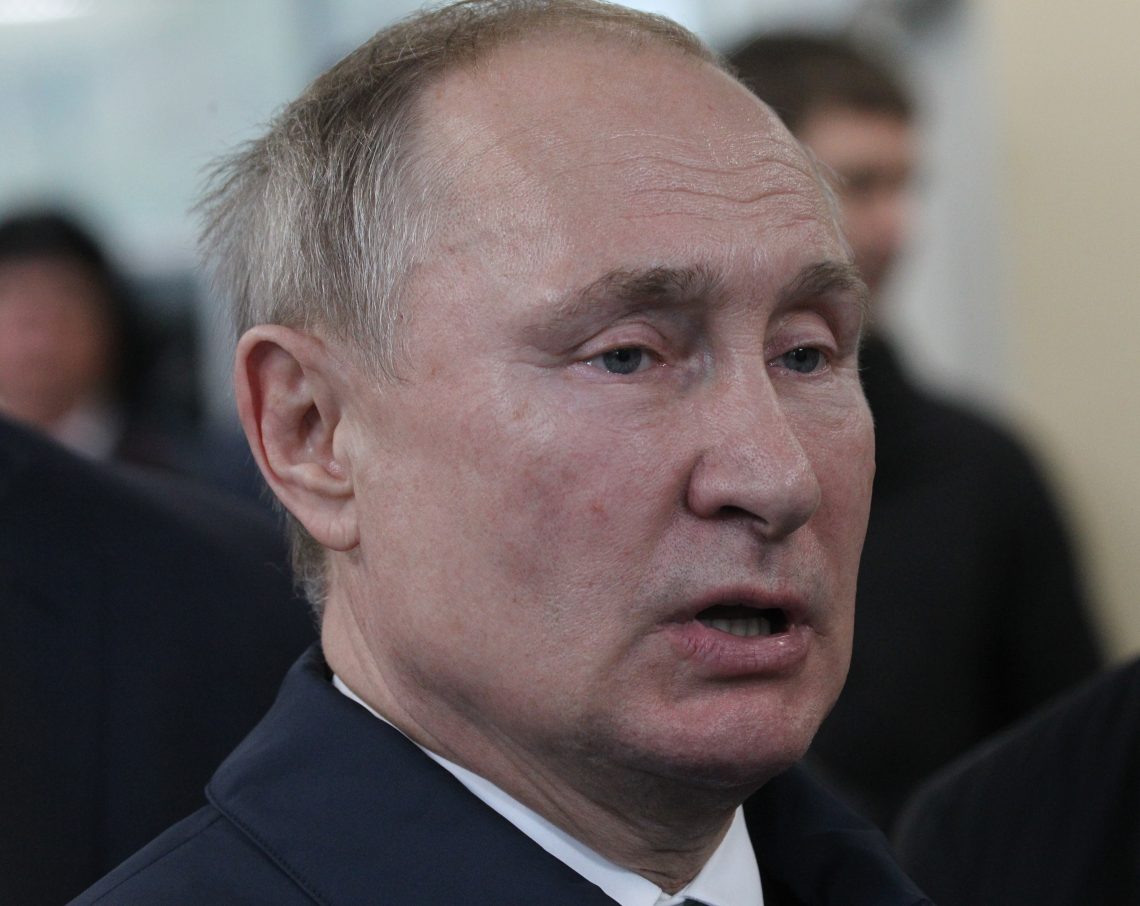Ukraine’s strategic communication in the war with Russia
Kyiv astutely communicates to its population, the West and the enemy to achieve its critical war objectives.

In a nutshell
- The leader of Ukraine has proven a very effective communicator
- Kyiv’s well-honed strategic messaging has multiple targets
- Among the key goals is weakening President Putin’s hold on power
The results of the armed clashes in southeastern Ukraine will ultimately decide the Russian-Ukrainian war’s outcome, perhaps as early as this year. The battlefield will determine the final shape of political agreements, either ending the war or suspending its armed dimension for some indefinite period. The winter, usually harsh in eastern parts of Europe, naturally reduces the scale and pace of combat operations. It ushers a period for intensifying various types of nonmilitary warfare, including in international strategic communications.
That is, in essence, a battle for the “hearts and minds” of the international community and the two warring nations – the Ukrainians and the Russians.
A case study
An example of such an operation was Ukrainian President Volodymyr Zelenskiy’s first wartime foreign visit to the United States in December 2022. A closer look at that event reveals its significance and possible impact on the war’s course.
Notably, President Zelenskiy’s meetings with U.S. President Joe Biden and his address to the U.S. Congress were not about securing more U.S. war materiel and more humanitarian, economic and financial aid from Ukraine’s strongest ally. In this regard, all arrangements had already been made before the visit – including, for example, the pivotal decision to provide Ukraine with air defense Patriot missile batteries.
Concerned Westerners may think: ‘It is not our war,’ or ‘It is costing us too much.’
Nor has the visit produced diplomatic-political breakthroughs. In this area, it confirmed the status quo and has not altered the arc of U.S.-Ukraine relations. However, the visit carried great importance in international strategic communication. In the coming months, its effects can be expected to bear on all critical strategic actors involved: the societies of the U.S. and, more broadly, the West as a whole and of Ukraine and Russia.
Staving off fatigue
Alarms about the growing “fatigue” in European societies becoming tired of dealing with the war’s fallout, including the economic burden and grave security concerns, have been heard for some time. Concerned Westerners may think: “It is not our war,” or “It is costing us too much.” And many may wonder whether it would not be better to sacrifice Ukraine (or at least part of its territory) for the sake of peace.
These are not only hypothetical worries of analysts, scientists, military planners and politicians. The attitude of Western citizens longing for the comforts of everyday peaceful life matters in the large scheme of things.
What caused the war, who is the aggressor and who is the victim, or what the strategic consequences of the conflict may be, are not so important. Most people do not think in such terms; what matters is their here and now. And now, it is colder at home. Life is becoming alarmingly expensive and more complicated than it was yesterday. Such fatigue with the war and abstraction from the strategic perspective favors the aggressor, Russia, and works against the victim, Ukraine. It discourages support for the victim because it prolongs its resistance to the aggression and thus prolongs the war.
Targeted communication
Hence the challenge and task for strategic communication: how to alleviate the war fatigue and keep Westerners in Ukraine’s corner? President Zelenskiy and his team are acutely mindful of this aspect of the battle. The president’s daily news releases are carefully designed for the Ukrainians’ consumption but also to motivate foreign allies and break the aggressor’s spirit. Mr. Zelenskiy proves a very effective operator in strategic communications – international and domestic.
From this vantage point, the president’s December 21, 2022, Washington visit, carried out jointly by Ukraine and the U.S., deserves particular attention. It reminded the policymakers and, perhaps most importantly, the American and broadly Western public, of the rationale for backing Ukraine in its struggle with Russia. It aimed to reinvigorate admiration for the Ukrainian army’s effectiveness and the civilian society’s sacrifices in defense of the homeland. It was also intended to make Westerners realize that supporting Ukraine is not some charity, because it directly serves the security interests of the Western world: Europe and the U.S. and NATO – especially the European alliance members of its so-called eastern flank.
The defensive will of the Ukrainian people is being put to another grave test. How to sustain the nation’s spirit in such a drastic situation?
It is apparent that, for a while, this Ukrainian-U.S. communication operation will help ease Western societies’ fatigue and make enduring economic hardship in the name of repelling Russian aggression politically easier. And since continued Western support of Ukraine is, in fact, the necessary condition for stopping Russian aggression in Europe, this aspect of the visit is of great practical and strategic importance.
The domestic impact
The Ukrainian nation is entering perhaps its most testing period since the beginning of the invasion. Russia, unable to defeat the Ukrainian army on the ground, has waged a total war directly against the entire society, attacking cities, population centers and civilian infrastructure with massive missile and drone strikes. This Russian strategy brings the conduct of the war directly into criminal territory. One can only hope that war criminals will be brought to justice and punished by international tribunals once the war is over.
The harsh effects of such a war are further compounded by the winter now underway. The media, traditional and social, provide countless images of the war drama. The defensive will of the Ukrainian people is being put to another grave test. Which raises the second major challenge facing wartime strategic communications: how to sustain the nation’s spirit in such a drastic situation?
Read more on Ukraine and Europe
Ukraine in a new security framework
President Zelenskiy’s visit to the U.S. may also prove helpful in this respect. The visit’s public resonance has given additional hope to the Ukrainians: they saw they were not left alone, that the biggest power of the Western world stood resolutely in their support and that there were chances to survive this dark period to win in the future. Anything that sustains the defensive determination of the Ukrainian people helps.
Within this framework, President Zelenskiy’s address to the U.S. Congress, delivered in person and in English, particularly stood out, for despite the horrors of the war, he eloquently showed his vision of a victorious and developing Ukraine.
Undermining Russia’s leader
The Russian public continues to support President Vladimir Putin and the war. However, doubts have already started surfacing. It is becoming increasingly difficult for Kremlin propaganda to spin its “special military operation” as a success – especially about how it has been conducted from the beginning. But the Kremlin’s particular problem is explaining the war’s rationale: why it had to invade its neighbor in February 2022.

This issue is made more acute by the palpable burden of the war’s consequences, including international economic sanctions, personnel losses at the front and the impacts of wartime mobilization at home. With no credible prospect of a quick end to these troubles, anti-war emotions are growing with each day of the war and may eventually reach a breaking point.
Fissures on the facade
Internal factional struggles have already emerged within the Russian power elite. One example is Yevgeny Prigozhin, a Russian oligarch and head of the so-called Wagner Group of mercenaries, a supposedly nongovernmental entity linked to the Russian special services. The Russian president’s confidant, Mr. Prigozhin is condescendingly called “Putin’s chef” for the catering services he arranged for the head of state. He is now in open conflict with Defense Minister Sergei Shoigu, Chief of General Staff General Valery Gerasimov and former President Dmitry Medvedev. Also, he has initiated a campaign along the lines of the communist-era populist prosecution of “bourgeois and kulaks,” which favors nationalizing the assets of some fellow oligarchs.
Such events also weaken confidence in the effectiveness of Mr. Putin’s personalized rule over Russia.
President Putin may have the situation under control for the time being, but information about his health troubles is regularly leaked – hardly by coincidence. The traditionally pro-Kremlin Russian public, susceptible to centralized propaganda, can easily change its sympathies and support for another, more robust “tsar.” President Putin’s regime is not as internally solid and stable as most Western experts and the public tend to see it from the outside.
In these circumstances, strategic communications with information that implicitly or explicitly weakens faith in the sense of the war and the omnipotence of the commander-in-chief, carry critical weight. Such is the news on President Zelenskiy’s latest U.S. visit, especially the elements showing the sustained support of Ukraine by Washington, followed by other Western capitals. That broadens doubts and may undermine the hope for a quick victory among the Russians. Such events also weaken confidence in the effectiveness of Mr. Putin’s personalized rule over Russia.
Scenarios
President Zelenskiy’s visit to Washington was important primarily as a message aimed at weakening the political-strategic position of Russia and increasing the chances of defeating the aggressor in the war.
Angry reaction
The outcome of this spectacular Ukrainian-American operation of strategic communication and how it may translate into possible war scenarios will depend – as with everything in war – on the actions of the two sides. The Russian response in the information sphere has been angry, albeit inconsistent. The thick threads with which it has been sewn together are probably visible to everyone, even in Russia. President Putin became hyperactive, giving several interviews to the media, and unleashed his two top war propaganda hounds in the form of Dmitry Medvedev and Foreign Minister Sergei Lavrov.
But the practical informational impact of Russia’s strategic communication moves is already low, and it probably only has the value of an echo returning to its senders. That is determined by the nearly global credibility collapse not only of the Russian propaganda machine itself but of the Russian state and, particularly, Mr. Putin’s political leadership.
Few in the world take what Mr. Putin says seriously now. Russia is weaker than Ukraine in the information ring, and Mr. Putin himself is dramatically losing the presidential communication battle for the hearts and minds of the world. President Zelenskiy is credible and open. President Putin seems unreliable, boring and secretive. President Zelenskiy attracts, Mr. Putin repels.
Win-win for Kyiv
Based on all this, we can envision two scenarios for Ukraine. One is radically favorable, and the other is moderately optimistic.
The former will occur if all three levels of Kyiv’s strategic communication targets – the Western international community, Ukrainians and Russians – prove simultaneously effective. A renewal of the West’s readiness to support Ukraine without previous self-restraint and enhancement of Ukrainians’ defensive resolve could lead to more battlefield victories and trigger a political change in Russia.
However, a moderate scenario still seems more likely. The West’s will to support Ukraine will not wane, and aid will be consistently sustained; in Russia, a political breakthrough has yet to take place, but the conditions for it will become increasingly apparent.









